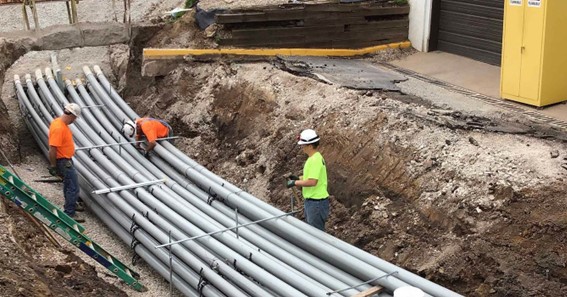Are you curious to know what is a duct bank? You have come to the right place as I am going to tell you everything about a duct bank in a very simple explanation. Without further discussion let’s begin to know what is a duct bank?
A duct bank is a group of underground conduits or ducts used to house electrical cables and communication wires. Duct banks are often found in urban areas where underground space is limited, and overhead lines are not feasible. In this blog, we’ll explore what a duct bank is, how it’s used, and why it’s important.
What Is A Duct Bank?
A duct bank is a system of underground ducts that houses electrical cables and communication wires. Duct banks can be made from a variety of materials, including PVC, concrete, or steel. The ducts are usually placed side by side and encased in a concrete surround, creating a protective channel for the cables and wires.
Duct banks can range in size from a few ducts to hundreds of ducts, depending on the size and complexity of the project. They can be located in a variety of settings, such as along city streets, under sidewalks, or beneath parking lots.
Click here – Exploring the Allure of English Golden Retrievers: What Sets Them Apart as a Truly Unique Breed
How Is A Duct Bank Used?
Duct banks are used to transport electrical power and communication signals from one location to another. They are often used in urban areas where underground space is limited, and overhead lines are not feasible. Duct banks can be used in a variety of applications, such as:
- Commercial Buildings: Duct banks can be used to connect power and communication lines to commercial buildings, such as office buildings, hotels, and shopping centers.
- Industrial Facilities: Duct banks can be used to supply power and communication lines to industrial facilities, such as manufacturing plants, refineries, and chemical plants.
- Transportation: Duct banks can be used to supply power and communication lines to transportation facilities, such as airports, train stations, and bus depots.
- Utilities: Duct banks can be used to house power and communication lines for utilities, such as water, gas, and electric companies.
Why Is A Duct Bank Important?
Duct banks are an important component of modern infrastructure. They provide a safe and secure environment for electrical cables and communication wires, protecting them from damage and ensuring reliable service. Duct banks also help to reduce the visual impact of overhead lines, improving the aesthetics of urban areas.
In addition, duct banks are designed to be easily accessible, making it easy to install, maintain, and repair cables and wires. This means that if a problem arises, it can be quickly identified and resolved, minimizing downtime and reducing the impact on businesses and residents.
Conclusion
In summary, a duct bank is a system of underground ducts used to house electrical cables and communication wires. They are used to transport power and communication signals from one location to another and are often found in urban areas where overhead lines are not feasible. Duct banks are an important component of modern infrastructure, providing a safe and secure environment for cables and wires and reducing the visual impact of overhead lines. They are designed to be easily accessible, making it easy to install, maintain, and repair cables and wires.
Get to know some more interesting facts on Petsbee
FAQ
What Is The Difference Between Duct And Duct Bank?
1.06 DEFINITIONS A. Duct: Interchangeable term for a conduit. B. Duct Bank: An assembly of conduits that may either be directly buried in the earth or encased in concrete.
Why Are Duct Banks Encased In Concrete?
RE: Reinforced concrete encased duct bank
The encasement is just to prevent a backhoe from damaging the conduits.
What Is A Fiber Duct Bank?
A fiber optic duct bank means a conduit or duct to be exclusively occupied by fiber optic cable.
How Deep Is A Duct Bank?
Depth: Depth: Install the top of the duct bank at 36 inches (900 mm) below the finished grade, unless otherwise indicated. 9. Stub-Ups: Use manufactured rigid steel conduit elbows for stub-ups at poles and equipment and at building entrances through the floor for all circuit conductors.
I Have Covered All The Following Queries And Topics In The Above Article
What Is Considered A Duct Bank?
What Is The Purpose Of A Duct Bank
What Is A Direct Burial Duct Bank
What Is A Duct Bank?
Duct Bank Vs Conduit
Duct Bank Vs Trench
Concrete Duct Bank Specifications
Duct Bank Installation
Nec Duct Bank Requirements
Underground Electrical Duct Bank Design
What Is A Duct Bank
What is a duct bank?
